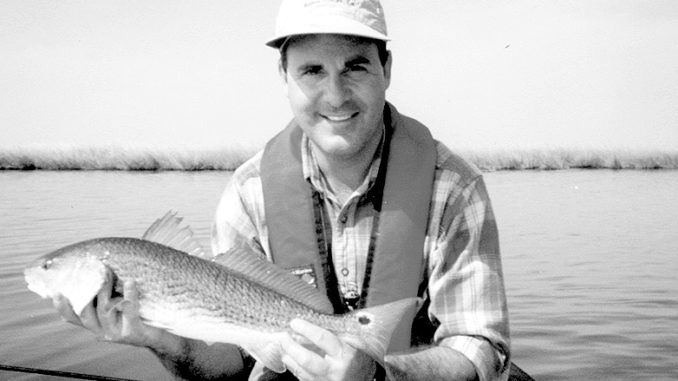
Several guides operating out of Empire and Buras spend the month of April fishing the east side of the river. There’s a very good reason for that.
You might think I’m crazy when I say more and more people in this state are getting into fly fishing. Well, I’m not crazy — four of the five voices inside my head tell me I’m not.
Regardless, these folks want answers to very important questions, like “What color is an olive woolybugger?” Hmmm… olive perhaps? Let’s stick to the easier questions.
Q. Some call for keeping a stiff wrist when casting, while others, notably Doug Swisher, incorporate the use of the wrist. Which is correct?
— N.L., Lafayette
A. Any casting method will work as long as it obeys the physics of fly casting: a) the rod tip travels in a fairly straight line, usually accomplished by a tight casting arc, b) each stroke starts slowly and accelerates to a hard stop, and c) there is sufficient pause at the end of each stroke to allow the line to unfurl. Obey these, and you can cast with your arm, your wrist … heck, even your foot!
Beginners are advised to lock their wrist because often their biggest obstacle is keeping a tight arc. However, once you’ve mastered the timing and acceleration, try to learn Swisher’s “micro-second wrist.” For short casts up to 40 feet, it’s very efficient.
Q. I’m looking for my first fly rod. The catalog lists numerous brands, ranging from $60 to $600. Why do fly rods cost more than casting rods? Why do they have such variation in price?
— L.L., Baton Rouge
A. Bait casting is like throwing a tennis ball, fly casting is like throwing a ping pong ball with a rope attached. You actually throw the rope, so you need more energy and more precision. Fly rods are engineered to meet those higher demands.
Each advancement in rod technology requires that the initial prices cover the cost of development. Fortunately, like computers, the old tech gets cheaper. And it catches fish just as well. Another factor is the unconditional warranty now offered by most manufacturers. Replacement costs are also built into the price.
Those high-tech rods can do some incredible things. At the Shallow Water Expo, I consistently lined an Orvis T3 5-weight to 100 feet. That’s about 70 feet farther than where I catch most of my fish.
Go for a rod that is accurate and fits your casting stroke best. Test-cast as many rods as possible so you’re happy with your decision.
Q. Any recommendations on how to catch big bass on fly rod?
— J.S., Tioga
A. Yeah, buy a copy of Tom Nixon’s book, “Fly Tying and Fly Fishing for Bass and Panfish,” and better get it fast. Amazon.com shows it out of print, and I know it’s quickly becoming a collector’s item. I believe Gulf Coast Outfitters in Baton Rouge and Lakeside Outfitters in Metairie may have copies.
Catching big bass on fly is one of the toughest challenges there is.
Nixon, a resident of Lake Charles, developed patterns that emulated the commie lures. He also created conventional flies that had lots of bulk and action to attract bigger fish. With his Calcasieu Pig Boat and his Spinner flies, Master Jake and I have taken many bass over 4 pounds.
Q. What length/weight rod would you recommend for kayak fishing?
— J.A., Baton Rouge
A. I’m currently authoring a book on fly fishing the marshes from canoes and kayaks, and one of the points I drive home is that shorter is better. When you’re sitting in a kayak, you’re half your standup height. The difference between an 8 foot rod and a 9 foot rod seems like 2 feet.
In addition to handling, other advantages for the short rod include greater accuracy and the ability to undercut wind.
The bad news is that 8- or 8 1/2-foot rods in saltwater weights are rare. The good news is they’re rather common in 6 and 7 weights, which is what many yak anglers like to use for the Spottail Elvis. These lighter weights make finer presentations, and don’t spook fish as often.
Got questions? Got milk? We’ll take either. Just drop us a line at: Fly Fish Answer Man, PO Box 3761, Baton Rouge, LA 70821, or email catch@laflyfish.com.


